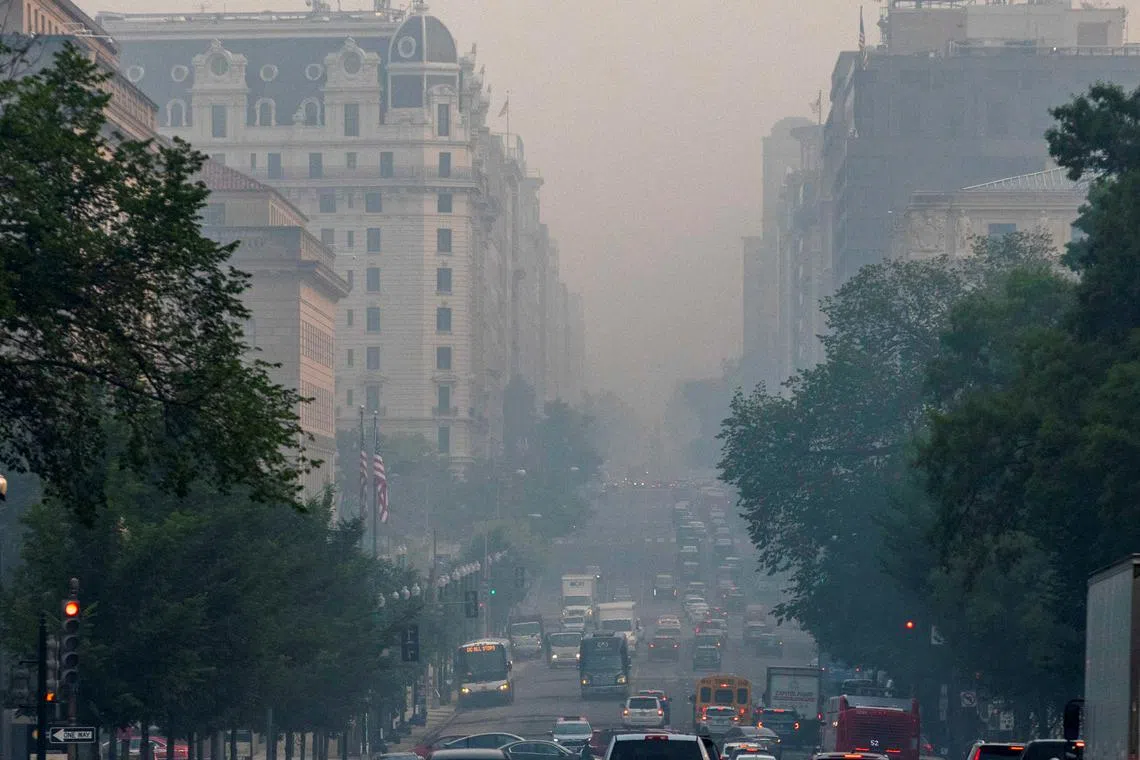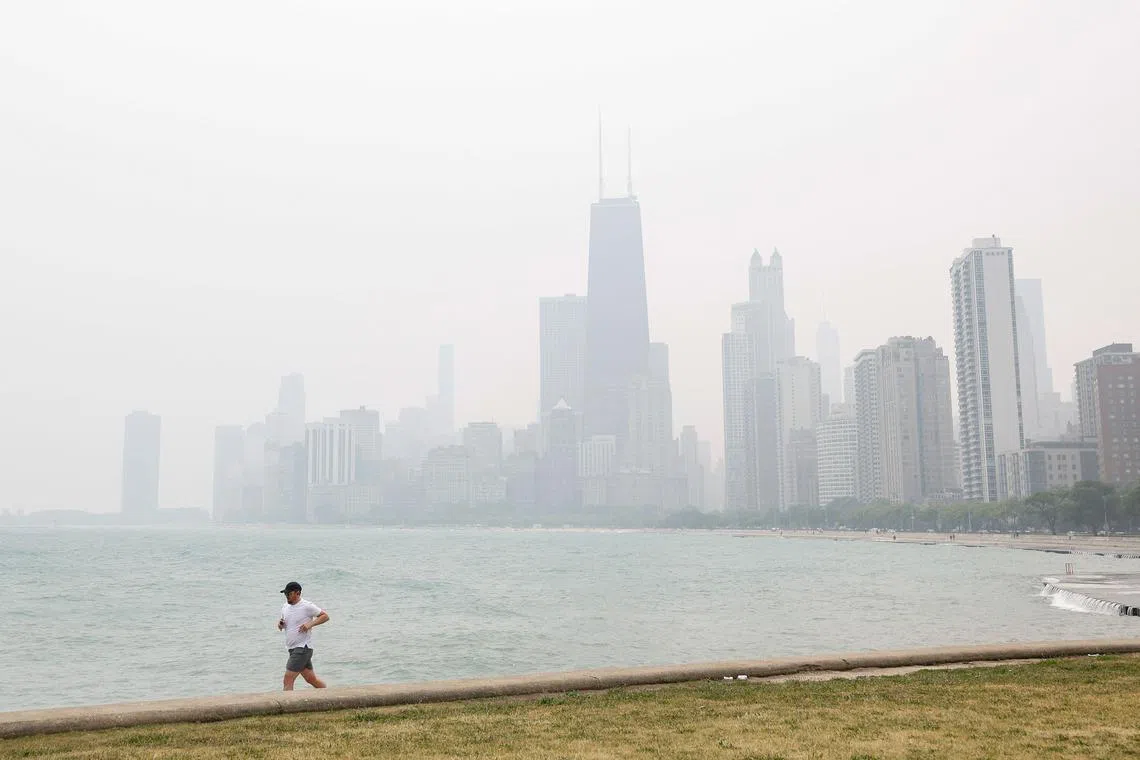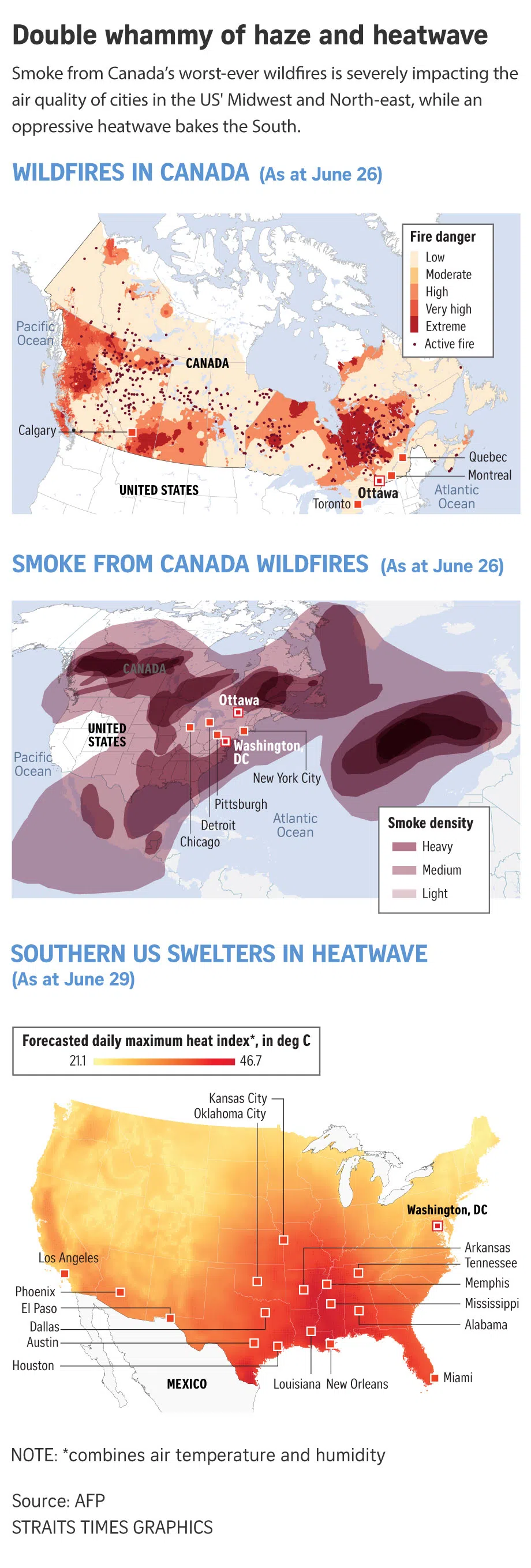US heads into holiday period amid severe heat in south, wildfire smoke in north-west
Sign up now: Get ST's newsletters delivered to your inbox

As of Wednesday evening in Washington, 127 million people were under air quality alerts, and 79 million more under heat alerts.
PHOTO: REUTERS
Follow topic:
WASHINGTON – Americans are heading into the weekend and the July 4 Independence Day holiday sandwiched between severe heat in the south and spreading smoke from wildfires in Canada in the north-west.
“Marine 1 emerged from the dense haze,” a White House travelling pool reporter wrote of President Joe Biden’s arrival on Wednesday in Chicago – America’s third-largest city – to deliver a key speech on the economy.
As at Wednesday evening in Washington, 127 million people nationwide were under air quality alerts, and 79 million more under heat alerts, according to the NBC News Weather Unit.
Across Canada, 490 fires were reported burning, with 255 considered “out of control”.
Smoke from the wildfires has been drifting south into the United States for more than a month, in a record-setting fire season in Canada which, according to reports, saw some 78,000 sq km consumed by the flames.
For the second time since early June, a mass of smoky haze is spreading across the Midwest, shrouding cities such as Pittsburgh and Detroit.
Residents in many of those cities, such as in Chicago, have resumed wearing masks outdoors.
On Wednesday, New York City and Washington were under the air quality index “code orange” of 101 to 150 – indicating the air was unhealthy for sensitive groups such as young children, the elderly and those with respiratory problems like asthma and bronchitis.
By Thursday morning, the air quality had worsened in Washington, with the sky a sickly shade of grey and the next level of air quality warning – code red – expected, to signal the air was unhealthy for the general population.
Meanwhile, in the South, millions of Americans are under heat advisories.
“It is hot even after the sun has gone down,” Mr Robert Kang, a resident of Austin, Texas, told The Straits Times.
“It’s not just hot in the middle of the day – even at 10pm or 11pm, when you walk outside, it’s still (32 deg C to 35 deg C),” said Mr Kang, who works in the tech and real estate sector.

Firefighters try to control a wildfire near Chibougamau, Quebec, Canada, on June 18, 2023.
PHOTO: AFP
On average, nights are warming faster than days in most of the US, according to the 2018 National Climate Assessment.
Southern Texas is at the centre of the heatwave. At least 13 people were reported to have died from heat-related illnesses in the last eight days, with the worst hit being Webb County, bordering Mexico.
Mexico has also been badly affected, with at least 112 people having died since March as a result of “natural extreme temperatures”, according to the country’s health authorities.
On Wednesday morning, the US National Weather Service posted on Twitter: “Dangerous heat in South Texas will continue into early next week, with… heat indices ranging from (42 deg C to 46.6 deg C) in the afternoons.”
On June 22, the United Farm Workers of America, an advocacy group, warned about the risks faced by people who work outdoors.
“Climate change is happening, and outdoor workers are more and more in danger every year,” it said.

On Wednesday, New York City and Washington were under the air quality index “code orange” of 101 to 150.
PHOTO: AFP
Meanwhile, average temperatures in Texas have been gradually rising.
“It’s not surprising for anyone who has been here at least one summer,” said Mr Kang, who now postpones walking his dog until later in the evening, when the heat is more bearable.
And the air-conditioners naturally run all day.
“It’s a 24/ 7 thing now,” he said.
This has put a strain on the energy grids of the affected states including Oklahoma, Louisiana, Mississippi, Arkansas, Alabama and Tennessee. Power disruptions have been reported in some areas.
But in Texas, solar power has helped. The North American Electric Reliability Corporation – a non-profit based in Atlanta, Georgia – estimates that the Lone Star State has added about 4.4GW of solar capacity since summer 2022.
Mr Jeff Berardelli, chief meteorologist at the Tampa, Florida TV station WFLA-TV, told TV network PBS: “The climate has warmed around 2 deg F (1.1 deg C) since around 1900.
“Now, that is when you consider both the land temperatures and the surface of the water. But land (temperature) has increased by about double the average of the earth’s increase.”
He continued: “In Texas specifically, we have seen an increase of around 3 deg F to 5 deg F (1.7 deg C to 2.8 deg C) during summertime.
“The baseline of these heatwaves starts a lot higher. So, the averages go up by a couple to a few degrees. The extremes go up by several degrees. In addition to the intensity of these heatwaves, we’re also seeing them last longer and occur more frequently.”
Meanwhile, the haze has been good for air purifier sales.
With some stores running out of air purifiers, online searches for them in June have been trending on Google.
E-commerce platform Amazon has also reportedly seen a spike in sales of air filters, as well as N95 and KN95 masks.



